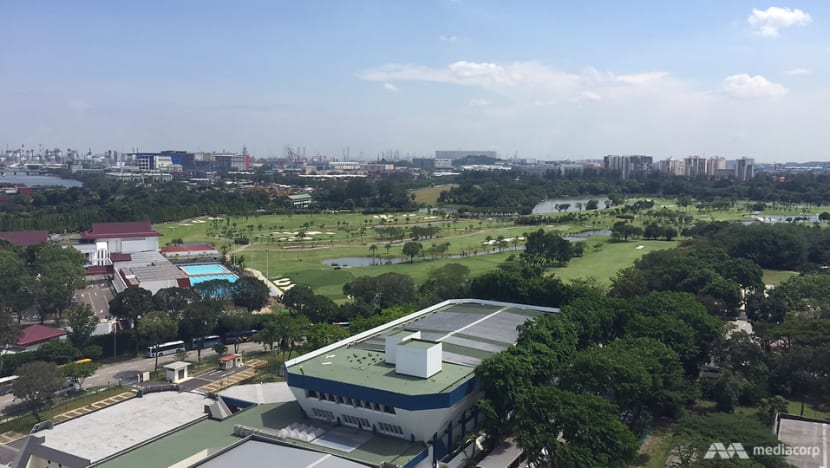More homes, commercial projects can be built on Jurong land meant for cancelled HSR project: Experts

Jurong Country Club (File photo: Imelda Saad)
SINGAPORE: More private homes, community facilities and even a retirement village - these are ideas that property analysts have mooted for large tracts of land in Jurong previously earmarked for the Kuala Lumpur-Singapore High-Speed Rail (HSR) project, which has since been scrapped.
Such developments will be in line with the overarching transformation plans for the western region of Singapore, they said, notably to turn Jurong Lake District into a second central business district in future.
The mega high-speed rail project, touted as a “game-changer” that would have cut travel time between Singapore and Kuala Lumpur to 90 minutes, came to a halt on Jan 1 after an agreement lapsed on Dec 31, 2020.
Malaysia has paid more than S$102 million in compensation to Singapore for the terminated project, said authorities on Monday.
READ: Assets company removal 'main concern' that led to HSR termination, project has cost Singapore more than S$270 million: Ong Ye Kung
TWO LAND PARCELS ACQUIRED
The Singapore Government had acquired two land parcels for the HSR project. One was the former Jurong Country Club site, measuring 67ha. Within this, 12ha had been set aside for the HSR terminus.
In a parliamentary reply in February, the National Development Ministry said that the entire plot is currently a white zone, subject to detailed planning, meaning it can house mixed developments.
“This remains consistent with our plans for the land to be used for new mixed-use, commercial and residential developments, as well as community facilities,” it said in the written answer.
The second parcel of land is the former Raffles Country Club site, spanning 143ha. Part of it was earmarked for the Integrated Train Testing Centre, which recently broke ground.
READ: From conception to termination: Timeline of KL-Singapore HSR project over 8 years
“These land parcels continue to be needed to realise our overall vision for Jurong Lake District, which is not affected by the termination of the HSR project," said the ministry.
“We will study the appropriate mix of uses for the parts of the land parcels initially set aside for the HSR to ensure that they tie in with the surroundings."
It added that it will make good use of these acquired land parcels to “realise their full potential value”.
TRANSFORMING JURONG
The 360ha Jurong Lake District, which comprises Jurong Lake and the area around Jurong East MRT station, has been positioned to be the country’s largest mixed-use business district outside the city centre.
Plans for the area include a commercial precinct, housing and expanded gardens.
In 2019, the Government also announced a 7ha integrated tourism development that will be set up from 2026.
The district is slated to be fully developed in 20 to 30 years. When ready, it is set to create more than 100,000 new jobs in the maritime, infrastructure and technology sectors, as well as an additional 20,000 homes.
But it is not just the scrapped HSR project that planners have to contend with. There is also the uncertainty caused by COVID-19.
READ: Terminated HSR project a missed opportunity to boost economic competitiveness for Singapore, KL: Experts
In January, developers, investors and businesses were invited to provide the Urban Redevelopment Authority (URA) with ideas for the Jurong Lake District, given the changes brought about by the pandemic.
The URA had told CNA last June that flexibility has been built into the master plan to cater to changing social and economic needs.
READ: New attractions, hotel in Jurong Lake District amid tourism boost
Experts like Mr Wong Xian Yang, Cushman & Wakefield Singapore’s head of research, have raised the possibility of some adjustments to the timing and scale of the planned hospitality and tourism projects.
But commercial and residential developments in the area will still be relevant, even without the HSR, he told CNA, noting that the Jurong Lake District has several merits such as “strong accessibility”.
It is also in close proximity to several tertiary institutions, as well as major commercial and industrial zones, he said.
IDEAS FOR LAND USE
As for how the extra space may be used, Mr Wong said: “Given that more companies are pursuing a hybrid work approach, perhaps we could see a higher proportion of residential and community facilities as companies do not need as much office space as before.”
He added that part of the land parcel may be tendered out to a master developer to ensure a well-curated vision of the precinct.
Ms Christine Sun, senior vice-president of research and analytics at OrangeTee & Tie, said there is room for more private homes to be built given how it “has been a while” since the Jurong East area has seen a new residential project.
HDB home owners in the area also have “upgrading needs", she added. "So it is good to offer new private homes for these people."
READ: Up Your Alley: Jurong, from 'cowboy town' to heritage hotspot
In addition, with the new Tengah estate starting to take shape, the population in the area is expected to grow.
“These people may go to Jurong to use the amenities. There will be an increase in footfall for retail shops and shopping malls in Jurong, and more people may choose to work in Jurong or Tuas,” said Ms Sun.
“Therefore, it is necessary for them to build more commercial, residential properties and amenities in Jurong Lake District to cater to the expansion in needs.”
Property analyst Ong Kah Seng suggested the possibility of developing retirement villages, particularly with lush greenery around the former Raffles Country Club site.
“Retirement homes need short leases (of up to 35 years). Hence, when the lease is up, these sites could be used for (the) HSR project should it get re-activated,” he said.
Specifically, Mr Ong suggested that the village could comprise a mix of small private condominiums and new HDB two-room Flexi flats for the elderly, with integrated medical care facilities and lifestyle amenities.
READ: Lakeside Garden opens to public under first phase of Jurong Lake Gardens
Mr Leonard Tay, who heads research at Knight Frank Singapore, said the absence of the HSR project means that prior strategies to grow the commercial and tourism sector in the Jurong Land District will have to be recalibrated for a post-pandemic future.
“The objectives of expanding new tourist target markets, exploring modes of connectivity and enhancing alternative modes of partnerships with Malaysia and other countries would have to be reassessed.”
He added that once regional economies have recovered from the crisis of the pandemic, some new cross-border infrastructure initiatives might be on the cards again.
“Jurong Lake District would be a choice location for when such a possibility materialises,” said Mr Tay.

















